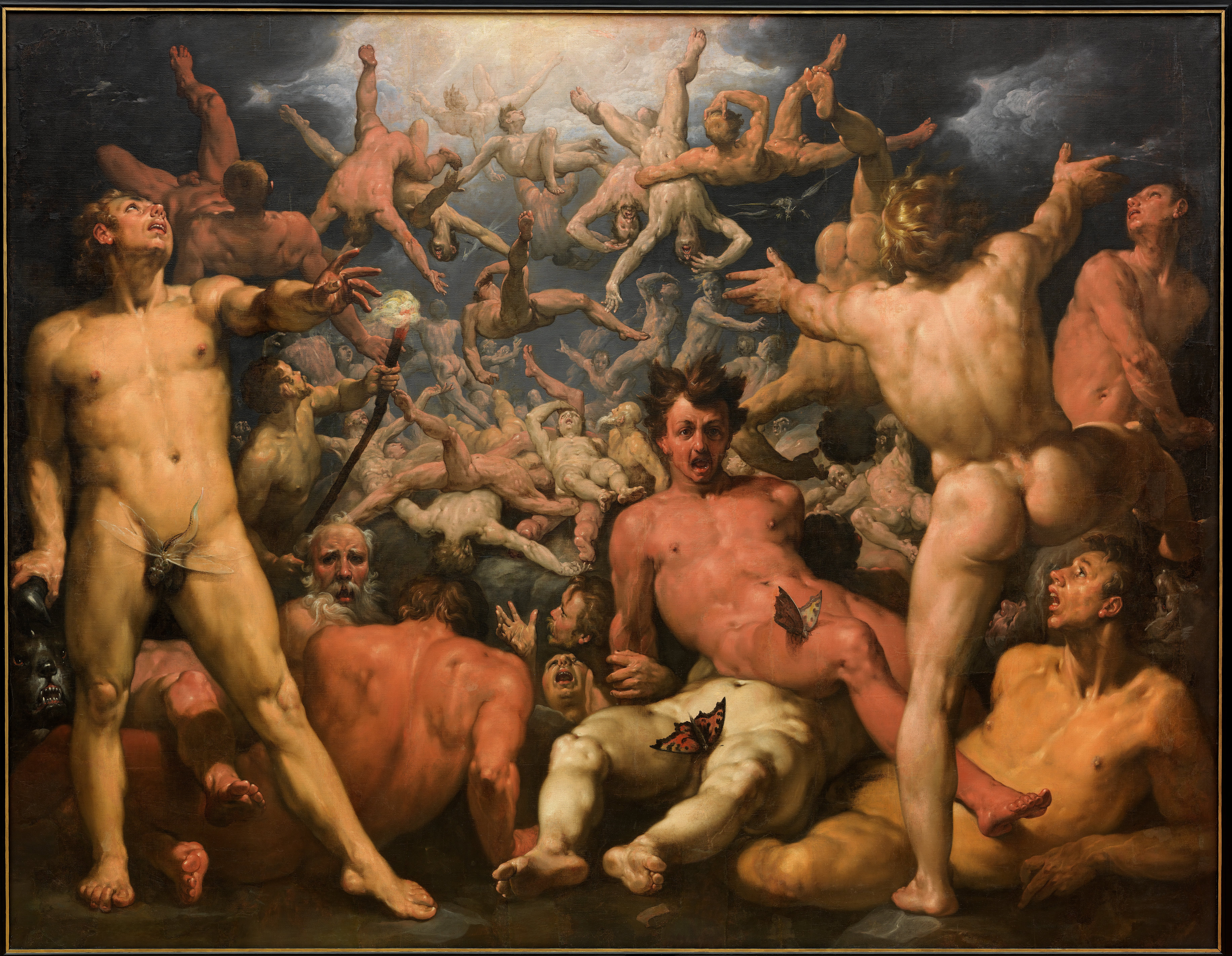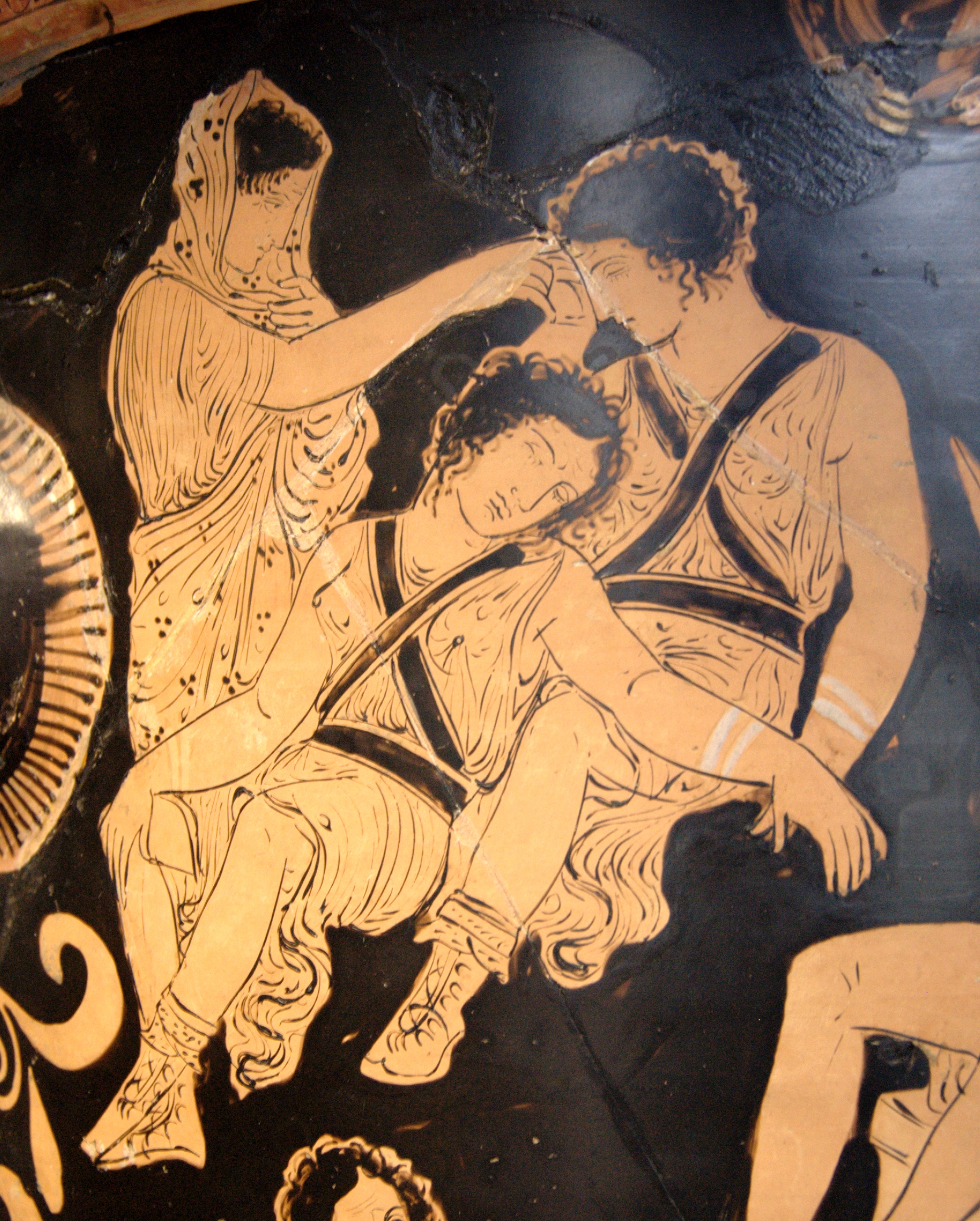|
Gigantes
In Greek mythology, Greek and Roman mythology, the Giants, also called Gigantes (Ancient Greek, Greek: ╬ô╬»╬│╬▒╬¢¤ä╬Á¤é, ''wiktionary:gigantes, G├¡gantes'', ╬ô╬»╬│╬▒¤é, ''wiktionary:gigas, G├¡gas''), were a race of great strength and aggression, though not necessarily of great size. They were known for the Gigantomachy (also spelled Gigantomachia), their battle with the Olympian gods. According to Hesiod, the Giants were the offspring of Gaia (Earth), born from the blood that fell when Uranus (mythology), Uranus (Sky) was castrated by his Titan (mythology), Titan son Cronus. Archaic and Classical representations show Gigantes as man-sized hoplites (heavily armed ancient Greek foot soldiers) fully human in form. Later representations (after c. 380 BC) show Gigantes with Anguiped, snakes for legs. In later traditions, the Giants were often confused with other opponents of the Olympians, particularly the Titan (mythology), Titans, an earlier generation of large and powerful children ... [...More Info...] [...Related Items...] OR: [Wikipedia] [Google] [Baidu] |
Gaia
In Greek mythology, Gaia (; , a poetic form of ('), meaning 'land' or 'earth'),, , . also spelled Gaea (), is the personification of Earth. Gaia is the ancestral motherÔÇösometimes parthenogenicÔÇöof all life. She is the mother of Uranus (Sky), with whom she conceived the Titans (themselves parents of many of the Olympian gods), the Cyclopes, and the Giants, as well as of Pontus (Sea), from whose union she bore the primordial sea gods. Her equivalent in the Roman pantheon was Terra.''Larousse Desk Reference Encyclopedia'', The Book People, Haydock, 1995, p. 215. Etymology The Greek name (''Gaia'' or ) is a mostly epic, collateral form of Attic (''G─ô'' ), and Doric (''Ga'' ), perhaps identical to (''Da'' ), both meaning "Earth". Some scholars believe that the word is of uncertain origin. Beekes suggested a probable Pre-Greek origin. Robert S. P. Beekes, ''Etymological Dictionary of Greek'', Brill, 2009, pp. 269ÔÇô270 (''s.v.'' "╬│ß┐å"). M.L. West derives the na ... [...More Info...] [...Related Items...] OR: [Wikipedia] [Google] [Baidu] |
Titan (mythology)
In Greek mythology, the Titans ( ; ) were the pre- Olympian gods. According to the ''Theogony'' of Hesiod, they were the twelve children of the primordial parents Uranus (Sky) and Gaia (Earth). The six male Titans were Oceanus, Coeus, Crius, Hyperion, Iapetus, and Cronus; the six female TitansÔÇöcalled the Titanides () or TitanessesÔÇöwere Theia, Rhea, Themis, Mnemosyne, Phoebe, and Tethys. After Cronus mated with his older sister Rhea, she bore the first generation of Olympians: the six siblings Zeus, Hades, Poseidon, Hestia, Demeter, and Hera. Certain other descendants of the Titans, such as Prometheus, Atlas, Helios, and Leto, are sometimes also called Titans. The Titans were the former gods: the generation of gods preceding the Olympians. They were overthrown as part of the Greek succession myth, which tells how Cronus seized power from his father Uranus and ruled the cosmos with his fellow Titans before being in turn defeated and replaced as the ruling pantheon o ... [...More Info...] [...Related Items...] OR: [Wikipedia] [Google] [Baidu] |
Cronus
In ancient Greek religion and Greek mythology, mythology, Cronus, Cronos, or Kronos ( or ; ) was the leader and youngest of the Titans, the children of Gaia (Earth) and Uranus (mythology), Uranus (Sky). He overthrew his father and ruled during the mythological Golden Age until he was overthrown by his son Zeus and imprisoned in Tartarus. According to Plato, however, the deities Phorcys, Cronus, and Rhea (mythology), Rhea were the eldest children of Oceanus and Tethys (mythology), Tethys. Cronus was usually depicted with a harpe, scythe, or sickle, which was the instrument he used to castrate and depose Uranus, his father. In Athens, on the twelfth day of the Attic month of Attic calendar, Hekatombaion, a festival called Kronia was held in honour of Cronus to celebrate the harvest, suggesting that, as a result of his association with the virtuous Golden Age, Cronus continued to preside as a List of agricultural gods, patron of the harvest. Cronus was also identified in classi ... [...More Info...] [...Related Items...] OR: [Wikipedia] [Google] [Baidu] |
Gigas
Gigas may refer to: * Gigas, one of the Gigantes (Giants) in Greek mythology * Gigas (company), a Spanish cloud services company * Guigass, a snow ape like kaiju from ''Ultraman'' * ''Codex Gigas'', a medieval manuscript * gigue The gigue ( , ) or giga () is a lively baroque dance originating from the English jig. It was imported into France in the mid-17th centuryBellingham, Jane"gigue."''The Oxford Companion to Music''. Ed. Alison Latham. Oxford Music Online. 6 July ... or giga, a dance ;People * (1899ÔÇô1976), German geodesist * Johannes Gigas (1514ÔÇô1581), German Protestant theologian, hymn writer, educator and Reformer * (1582ÔÇô1637), German cartographer See also * A. gigas (other) * D. gigas * E. gigas (other) * G. gigas * Giygas, a villain in the EarthBound/Mother series * H. gigas (other) * M. gigas (other) * P. gigas (other) * T. gigas (other) {{disambiguation ... [...More Info...] [...Related Items...] OR: [Wikipedia] [Google] [Baidu] |
Poseidon Polybotes Cdm Paris 573
Poseidon (; ) is one of the twelve Olympians in religion in ancient Greece, ancient Greek religion and Greek mythology, mythology, presiding over the sea, storms, earthquakes and horses.Burkert 1985pp. 136ÔÇô139 He was the protector of seafarers and the guardian of many Hellenic cities and colonies. In pre-Olympian Bronze Age Greece, Poseidon was venerated as a chief deity at Pylos and Thebes, Greece, Thebes, with the cult title "earth shaker"; in the myths of isolated Arcadia (ancient region), Arcadia, he is related to Demeter and Persephone and was venerated as a horse, and as a god of the waters.Seneca quaest. Nat. VI 6 :Nilsson Vol I p.450 Poseidon maintained both associations among most Greeks: he was regarded as the tamer or father of horses, who, with a strike of his trident, created springs (the terms for horses and springs are related in the Greek language).Nilsson Vol I p.450 His Interpretatio graeca, Roman equivalent is Neptune (mythology), Neptune. Homer and He ... [...More Info...] [...Related Items...] OR: [Wikipedia] [Google] [Baidu] |
Online Etymology Dictionary
Etymonline, or ''Online Etymology Dictionary'', sometimes abbreviated as OED (not to be confused with the ''Oxford English Dictionary'', which the site often cites), is a free online dictionary that describes the etymology, origins of English language, English words, written and compiled by Douglas R. Harper. Description Douglas R. Harper is an American Civil War historian and copy editor for LNP Media Group. He compiled the etymology dictionary to record the history and evolution of more than 50,000 words, including slang and technical terms. The core of its etymology information stems from ''The Barnhart Dictionary of Etymology'' by Robert Barnhart, Ernest Klein's ''Comprehensive Etymology Dictionary of the English Language'', ''The Middle English Compendium'', ''The Oxford English Dictionary'', and the 1889ÔÇô1902 ''Century Dictionary''. Harper also researches on digital archives. On the ''Etymonline'' homepage, Harper says that he considers himself "essentially and for the m ... [...More Info...] [...Related Items...] OR: [Wikipedia] [Google] [Baidu] |
Cyclopes
In Greek mythology and later Roman mythology, the Cyclopes ( ; , ''KÛklōpes'', "Circle-eyes" or "Round-eyes"; singular Cyclops ; , ''KÛklōps'') are giant one-eyed creatures. Three groups of Cyclopes can be distinguished. In Hesiod's ''Theogony'', the Cyclopes are the three brothers, Brontes, Steropes, and Arges (Cyclops), Arges, who made Zeus's weapon, the thunderbolt. In Homer's ''Odyssey'', they are an uncivilized group of shepherds, the brethren of Polyphemus encountered by Odysseus. Cyclopes were also famous for being the builders of the Cyclopean masonry, Cyclopean walls of Mycenae and Tiryns. In ''Cyclops (play), Cyclops'', the fifth-century BC play by Euripides, a satyr play, chorus of satyrs offers comic relief based on the encounter of Odysseus and Polyphemus. The third-century BC poet Callimachus makes the Hesiodic Cyclopes the assistants of smith-god Hephaestus, as does Virgil in the Latin epic ''Aeneid'', where he seems to equate the Hesiodic and Homeric Cyclop ... [...More Info...] [...Related Items...] OR: [Wikipedia] [Google] [Baidu] |
Hundred-Handers
In Greek mythology, the Hecatoncheires (), also called Hundred-Handers or Centimanes (; ), were three monstrous giants, of enormous size and strength, each with fifty heads and one hundred arms. They were individually named Cottus (the furious), Briareus (or Aegaeon, the sea goat) and Gyges (or Gyes, the long-limbed). In the standard tradition, they were the offspring of Uranus (Sky) and of Gaia (Earth), and helped Zeus and the Olympians to overthrow the Titans in the Titanomachy. Names The three Hundred-Handers were named Cottus, Briareus and Gyges. Cottus (''╬ܤî¤ä¤ä╬┐¤é'') is a common Thracian name, and is perhaps related to the name of the Thracian goddess Kotys. The name Briareus (''╬Ƥü╬╣╬¼¤ü╬Á¤ë¤é'') was probably formed from the Greek ''╬▓¤ü╬╣╬▒¤ü¤î¤é'' meaning "strong". Hesiod's ''Theogony'' also calls him "Obriareus". The name Gyges is possibly related to the mythical Attic king Ogyges (''ߢ¿╬│¤ì╬│╬À¤é''). "Gyes", rather than Gyges, is found in some texts. Homer's '' ... [...More Info...] [...Related Items...] OR: [Wikipedia] [Google] [Baidu] |
Adamant
Adamant in classical mythology is an archaic form of diamond. In fact, the English word ''diamond'' is ultimately derived from ''adamas'', via Late Latin and Old French . In ancient Greek (), genitive (), literally 'unconquerable, untameable'. In those days, the qualities of hard metal (probably steel) were attributed to it, and ''adamant'' became an independent concept as a result. In the Middle Ages adamant also became confused with the magnetic rock lodestone, and a folk etymology connected it with the Latin , 'to love or be attached to'. Another connection was the belief that adamant (the diamond definition) could block the effects of a magnet. This was addressed in chapter III of ''Pseudodoxia Epidemica'', for instance. Since the contemporary word ''diamond'' is now used for the hardest gemstone, the increasingly archaic noun ''adamant'' has been reduced to mostly poetic or anachronistic use. In that capacity, the name, and various derivatives of it, are frequently used i ... [...More Info...] [...Related Items...] OR: [Wikipedia] [Google] [Baidu] |
Erinyes
The Erinyes ( ; , ), also known as the Eumenides (, the "Gracious ones"), are chthonic goddesses of vengeance in ancient Greek religion and mythology. A formulaic oath in the ''Iliad'' invokes them as "the Erinyes, that under earth take vengeance on men, whosoever hath sworn a false oath". Walter Burkert suggests that they are "an embodiment of the act of self-cursing contained in the oath". Their Roman counterparts are the Furies, also known as the Dirae. The Roman writer Maurus Servius Honoratus ( AD) wrote that they are called "Eumenides" in hell, "Furiae" on Earth, and "Dirae" in heaven. Erinyes are akin to some other Greek deities, called Poenai. According to Hesiod's '' Theogony'', when the Titan Cronus castrated his father, Uranus, and threw his genitalia into the sea, the Erinyes (along with the Giants and the Meliae) emerged from the drops of blood which fell on the Earth ( Gaia), while Aphrodite was born from the crests of sea foam. Apollodorus also re ... [...More Info...] [...Related Items...] OR: [Wikipedia] [Google] [Baidu] |
Meliai
In Greek mythology, the Meliae (also called Meliads) (; or ) were usually considered to be the nymphs of the ash tree, whose name they shared. Mythology According to Hesiod, the Meliae (probably meaning all tree-nymphs) were born from the drops of blood that fell on Gaia arthwhen Cronus castrated Uranus. In Hesiod's ''Works and Days'', the ash trees, perhaps meaning the Melian nymphs, are said to have been the progenitors of the generation of men belonging to Hesiod's Bronze Age. The Meliae were nurses of the infant Zeus in the Cretan Dikti mountains, according to the 3rd century BC poet Callimachus, ''Hymn to Zeus'', where they fed him on the milk of the goat Amalthea and honey. Callimachus appears to make the Theban nymph Melia, who was, by Apollo, the mother of Tenerus (son of Apollo), Tenerus and Ismenus, one of the "earth-born" Meliae. Elsewhere, however, this Melia is an Oceanid, one of the many daughters of Oceanus and Tethys (mythology), Tethys. The mythographe ... [...More Info...] [...Related Items...] OR: [Wikipedia] [Google] [Baidu] |







